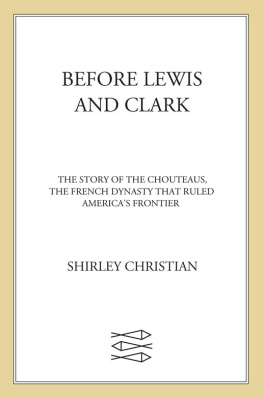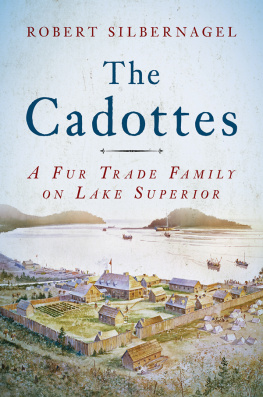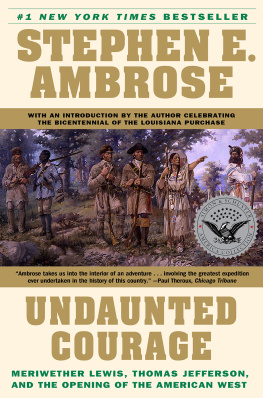ISBN for this digital edition: 978-0-8263-4349-9
2008 by the University of New Mexico Press
All rights reserved. Published 2008
Printed in the United States of America
13 12 11 10 09 08 1 2 3 4 5 6
The Library of Congress has cataloged the printed edition as follows:
Hoig, Stan.
The Chouteaus : first family of the fur trade / Stan Hoig.
p. cm.
Includes bibliographical references and index.
ISBN 978-0-8263-4347-5 (cloth : alk. paper)
1. Chouteau family.
2. PioneersMissouriSaint LouisBiography.
3. Fur tradersMissouriSaint LouisBiography.
4. French AmericansMissouriSaint LouisBiography.
5. BusinessmenMissouriSaint LouisBiography.
6. Saint Louis (Mo.)Biography.
7. Missouri River ValleyBiography.
8. Fur tradeMissouri River ValleyHistory.
9. Frontier and pioneer lifeMissouri River Valley.
10. Missouri River ValleyHistory.
I. Title.
F474.S253A245 2008
977.86600922dc22
[B]
2007041680
PREFACE
ALTHOUGH CLEARLY ITS ANCESTRAL BASE is St. Louis, Missouri, the Chouteau story is prefatory to the early histories of many western states. It traces much of the fur trade and speaks to the awakening of the American West to the outside world. It is in part a personality and character story, but also much more in a larger sense. For whatever their ethical purpose, the Chouteaus were significant players in the initial exploitation of the vast lands that lay so mysteriously inviting beyond the Mississippi River during their day. At the very least, their era represents a truly grand adventure of American history, worthy of remembrance.
To a large degree, the saga of the Chouteau family is the story of two sets of brothers. The elders, Auguste and Pierre, were instrumental, along with Pierre Laclde, in founding the city of St. Louis; in the development of the important fur trade along the Mississippi and lower Missouri rivers; and in providing critical aid to the young, still tentative United States in establishing its claim to the lands of the Louisiana Purchase and winning the friendship of Indian tribes of the region. The two were intimate advisors to Thomas Jefferson, Meriwether Lewis, and William Clark, as well as acquaintances of many other notable men of Americas early history.
Pierres eight sons in particular left their mark on the American West through their adventures in the fur trade and their close relationship with Indian tribes beyond the Mississippi. Most notable were Auguste Pierre (Col. A. P.), participant in numerous western adventuresamong them, imprisonment in a Spanish dungeon at Santa Fe, New Mexico; the Battle of Arikara Village; and the Battle of Chouteaus Island, Kansasand his younger brother Pierre Jr. (Cadet), who administratively brought steamboats to the Upper Missouri and established numerous trading posts on the frontier. He became the namesake of Fort Pierre and Pierre, South Dakota, and heir to John Jacob Astors monumental American Fur Company.
Auguste sired five girls and four boys, who led varied careers. His attempt to formally educate the oldest son, Auguste Aristide, was a painful failure until the boy escaped back to the Indian frontier he loved, serving there as a treaty interpreter. Gabriel Sylvestre (Cerr or Seres), another early Kansas trader, later moved on to operate at Fort Union, North Dakota. Henry Pierre, a St. Louis railroad entrepreneur, perished in a train that crashed into the flooded Gasconade River while crossing over a weakened trestle bridge. Little is recorded of Augustes son, Edward Ren. Of the girls, Marie Thrse and Catherine Emilie died young; Marie Thrse Eulalie and Marie Louise married brothers Ren and Gabriel Paul; and Emilie Antoinette married Capt. Thomas F. Smith.
Auguste Pierre and Pierre Jr., Pierres elder sons, were born of the same mother, Pelagie Kiersereau. They were reared in much the same fashion by Pierre and stood with one another as brothers. But fate brought them to far different ends. In contrast to Eugene ONeills brothers in Beyond the Horizon, the adventurous one went afield while the less robust one stayed home and ran the family business. Col. A. P. won high respect for his courage and fairness with the Indians, but died in the western wilderness amidst financial ruin. Pierre Jr., though hated by competitors for his unscrupulous dealings, made a fortune, becoming one of the richest men of his day.
But they were not the only sons of Pierre Chouteau who were active on the western frontier. Pierres third son, Paul Liguestalso by Pelagie Kiersereaubecame a fur trader in the wilds of Kansas at the age of fifteen, an Indian agent for the Osages, and a government emissary to the tribes of Indian Territory (now Oklahoma).
Pierres half brothers Franois, Cyprien, and Frederick, born of Brigitte Saucier, were also active Indian traders and pioneers in presettlement Kansas. Their full brother Pharamond worked for Auguste Pierre at Fort Gibson, Indian Territory, and served briefly as Creek Indian agent before his untimely death there at age twenty-five. Even Pierres daughter Pelagie wedded into fur-trade fame with her marriage to Bartholomew Berthold, whose name is remembered by Fort Berthold, North Dakota.
As is the case with most historical studies, this book is much indebted to other historians and scholars. Though this work presents additional material and perspective on the Chouteau family, it draws upon the historical resources and information provided by those predecessors who have researched and studied the Chouteau family and the era of early American history in which the Creole traders so fully participated. Principal among these writers was the illustrious historian and Chouteau family descendant John Francis McDermott.
McDermott left behind not only a body of published literature on the Chouteaus and their St. Louis environs but also his most useful collection of research material. This latter is held by the Lovejoy Library University Archives, Southern Illinois University at Edwardsville. The McDermott Collection was made available through the willing and generous assistance of archivist/specialist Amanda Bahr Evola and Steve Kerber.
The numerous writings of historians William E. Foley and C. David Rice are vital contributions to the history of the Chouteau family. The translation and presentation of the letters of Franois and Berenice Chouteau by Dorothy Brandt Marra, translator Marie-Laure Dionne Pal, and editor David Boutrous were invaluable. Shirley Christians well-presented study of the Chouteaus is both comprehensive and thorough.









